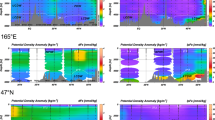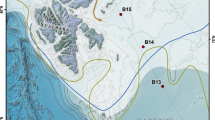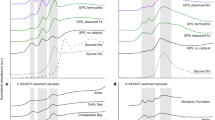Abstract
Hydrothermal venting associated with mid-ocean ridge volcanism is globally widespread1. This venting is responsible for a dissolved iron flux to the ocean that is approximately equal to that associated with continental riverine runoff2. For hydrothermal fluxes, it has long been assumed that most of the iron entering the oceans is precipitated in inorganic forms. However, the possibility of globally significant fluxes of iron escaping these mass precipitation events and entering open-ocean cycles is now being debated3, and two recent studies suggest that dissolved organic ligands might influence the fate of hydrothermally vented metals4,5. Here we present spectromicroscopic measurements of iron and carbon in hydrothermal plume particles at the East Pacific Rise mid-ocean ridge. We show that organic carbon-rich matrices, containing evenly dispersed iron(II)-rich materials, are pervasive in hydrothermal plume particles. The absence of discrete iron(II) particles suggests that the carbon and iron associate through sorption or complexation. We suggest that these carbon matrices stabilize iron(II) released from hydrothermal vents in the region, preventing its oxidation and/or precipitation as insoluble minerals. Our findings have implications for deep-sea biogeochemical cycling of iron, a widely recognized limiting nutrient in the oceans.
This is a preview of subscription content, access via your institution
Access options
Subscribe to this journal
Receive 12 print issues and online access
$259.00 per year
only $21.58 per issue
Buy this article
- Purchase on Springer Link
- Instant access to full article PDF
Prices may be subject to local taxes which are calculated during checkout


Similar content being viewed by others
References
German, C. R. & von Damm, K. L. Hydrothermal processes. Treatise Geochem. 6, 181–222 (2004).
Elderfield, H. & Schultz, A. Mid-ocean ridge hydrothermal fluxes and the chemical composition of the ocean. Annu. Rev. Earth Planet. Sci. 24, 191–224 (1996).
SCOR Working Group.SCOR GEOTRACES— An international study of the global marine biogeochemical cycles of trace elements and their isotopes. Chem. der Erde 67, 85–131 (2007).
Bennett, S. A. et al. The distribution and stabilisation of dissolved Fe in deep-sea hydrothermal plumes. Earth Planet. Sci. Lett. 270, 157–167 (2008).
Sander, S. G. et al. Organic complexation of copper in deep-sea hydrothermal vent systems. Environ. Chem. 4, 81–89 (2007).
Feely, R. A. et al. Composition and dissolution of black smoker particulates from active vents on the Juan de Fuca Ridge. J. Geophys. Res. 92, 11347–11363 (1987).
German, C. R., Campbell, A. C. & Edmond, J. M. Hydrothermal scavenging at the Mid-Atlantic Ridge: Modification of trace element dissolved fluxes. Earth Planet. Sci. Lett. 107, 101–114 (1991).
Field, M. P. & Sherrell, R. M. Dissolved and particulate Fe in a hydrothermal plume at 9∘45′ N, East Pacific Rise: Slow Fe(II) oxidation kinetics in Pacific plumes. Geochim. Cosmochim. Acta 64, 619–628 (2000).
Statham, P. J., German, C. R. & Connelly, D. P. Iron(II) distribution and oxidation kinetics in hydrothermal plumes at the Kairei and Edmond vent sites, Indian Ocean. Earth Planet. Sci. Lett. 236, 588–596 (2005).
Cowen, J. P., Massoth, G. J. & Baker, E. T. Bacterial scavenging of Mn and Fe in a mid- to far-field hydrothermal particle plume. Nature 322, 169–171 (1986).
Shock, E. L. & Schulte, M. D. Organic synthesis during fluid mixing in hydrothermal systems. J. Geophys. Res. 103, 28513–28527 (1998).
Chan, C. S. et al. Microbial polysaccharides template assembly of nanocrystal fibers. Science 303, 1656–1658 (2004).
Toner, B. et al. Spatially resolved characterization of biogenic manganese oxide production within the biofilm of Pseudomonas putida strain MnB1. Appl. Environ. Microbiol. 71, 1300–1310 (2005).
Moffett, J. W., Goepfert, T. J. & Naqvi, S. W. A. Reduced iron associated with secondary nitrite maxima in the Arabian Sea. Deep-Sea Res. 54, 1341–1349 (2007).
Millero, F. J., Sotolongo, S. & Izaguirre, M. The oxidation kinetics of Fe(II) in seawater. Geochim. Cosmochim. Acta 51, 793–801 (1987).
Martell, A. E. & Smith, R. M. Critical Stability Constants Vol. 3: Other Organic Ligands (Plenum Press, 1989).
Ciglenecki, I. et al. The role of reduced sulfur species in the coalescence of polysaccharides in the Adriatic Sea. Mar. Chem. 71, 233–249 (2000).
Feely, R. A., Gendron, J. F., Baker, E. T. & Lebon, G. T. Hydrothermal plumes along the East Pacific Rise, 8∘40 to 11o50: Particle distribution and composition. Earth Planet. Sci. Lett. 128, 19–36 (1994).
Roth, S. E. & Dymond, J. Transport and settling of organic material in a deep-sea hydrothermal plume: Evidence from particle flux measurements. Deep-Sea Res. 36, 1237–1254 (1989).
Lang, S. Q. et al. Dissolved organic carbon in ridge-axis and ridge-flank hydrothermal systems. Geochim. Cosmochim. Acta 70, 3830–3842 (2006).
Honjo, S., Manganini, S. J., Krishfield, R. A. & Francois, R. Particulate organic carbon fluxes to the ocean interior and factors controlling the biological pump: A synthesis of global sediment trap programs since 1983. Prog. Oceanogr. 76, 217–285 (2008).
Verdugo, P. et al. The oceanic gel phase: A bridge in the DOM-POM continuum. Mar. Chem. 92, 67–85 (2004).
Engel, A. et al. Polysaccharide aggregation as a potential sink of marine dissolved organic carbon. Nature 428, 929–932 (2004).
Chin, W.-C., Orellana, M. V. & Verdugo, P. Spontaneous assembly of marine dissolved organic matter into polymer gels. Nature 391, 568–572 (1998).
Wakeham, S. G., Cowen, J. P., Burd, B. J. & Thomson, R. E. Lipid-rich ascending particles from the hydrothermal plume at Endeavour Segment, Juan de Fuca Ridge. Geochim. Cosmochim. Acta 65, 923–939 (2001).
Shackelford, R. & Cowen, J. P. Transparent exopolymer particles (TEP) as a component of hydrothermal plume particulate dynamics. Deep-Sea Res. I 53, 1677–1694 (2006).
Lyle, M. W. Major element composition of Leg 92 sediments. Initial Reports of the Deep Sea Drilling Project Vol. 92, 355–370 (1986).
Lupton, J. E. Hydrothermal helium plumes in the Pacific Ocean. J. Geophys. Res. 103, 15853–15868 (1998).
Feely, R. A. et al. Hydrothermal plume particles and dissolved phosphate over the superfast-spreading southern East Pacific Rise. Geochim. Cosmochim. Acta 60, 2297–2323 (1996).
Comtet, T. et al. Molecular and morphological identification of settlement-stage vent mussel larvae, Bathymodiolus azoricus (Bivalvia: Mytilidae), preserved in situ at active vent fields on the Mid-Atlantic Ridge. Limnol. Oceanogr. 45, 1655–1661 (2002).
Honjo, S., Dymond, J., Collier, R. & Manganini, S. J. Export production of particles to the interior of the equatorial Pacific Ocean during the 1992 EqPac experiment. Deep-Sea Res. 42, 831–870 (1995).
Hitchcock, A. P. <http://unicorn.mcmaster.ca/aXis2000.html>.
Myneni, S. C. B. in Applications of Synchrotron Radiation in Low-Temperature Geochemistry and Environmental Science Vol. 49 (eds Fenter, P. A., Rivers, M. L., Sturchio, N. C. & Sutton, S. R.) (The Mineralogical Society of America and The Geochemical Society, 2002).
Acknowledgements
We thank D. Adams, S. Beaulieu, S. Mills, B. Govenar and T. Shank for trap deployment/collection; J. P. Cowen, K. Von Damm, A. Thurnherr (NSF Ridge 2000), L. Mullineaux, J. Ledwell and A. Thurnherr (NSF OCE BIO and PO) for cruise berths; C. S. Chan for STXM standards; and ALS BL 10.3.2 users for Fe K-edge XAS reference spectra. Financial support: NASA Postdoctoral Program (B.M.T.), NSF OCE 0425737 (K.J.E. and J.W.M.), WHOI DOEI (L. Mullineaux, O.R., C.R.G. and K.J.E.), NSF OCE 0648287 (K.J.E., C.R.G. and O.R.) and NSF OCE 0424953 (L. Mullineaux). The Advanced Light Source is supported by the Office of Science, Basic Energy Sciences, Division of Materials Science of the US Department of Energy under contract No. DE-AC02-05CH11231.
Author information
Authors and Affiliations
Contributions
Manuscript preparation, ALS beamtime proposals and spectroscopy data collection–analysis–interpretation (B.M.T); spectroscopy data collection–analysis–interpretation (S.C.F.), inductively coupled plasma optical emission spectrometry measurements (S.J.M.); spectroscopy data collection (C.M.S.); mineralogy data analysis (M.A.M.); project planning, data interpretation and mentoring (K.J.E, C.R.G, O.R., J.W.M)
Corresponding author
Supplementary information
Rights and permissions
About this article
Cite this article
Toner, B., Fakra, S., Manganini, S. et al. Preservation of iron(II) by carbon-rich matrices in a hydrothermal plume. Nature Geosci 2, 197–201 (2009). https://doi.org/10.1038/ngeo433
Received:
Accepted:
Published:
Issue Date:
DOI: https://doi.org/10.1038/ngeo433
This article is cited by
-
Biogeochemistry of Earth before exoenzymes
Nature Geoscience (2023)
-
More than redox, biological organic ligands control iron isotope fractionation in the riparian wetland
Scientific Reports (2021)
-
Utilizing 234Th/238U disequilibrium to constrain particle dynamics in hydrothermal plumes in the Southwest Indian Ocean
Acta Oceanologica Sinica (2021)
-
Impacts of hydrothermal plume processes on oceanic metal cycles and transport
Nature Geoscience (2020)
-
The Mineral Composition and Sources of the Fine-Grained Sediments from the 49.6°E Hydrothermal Field at the SWIR
Journal of Ocean University of China (2020)



